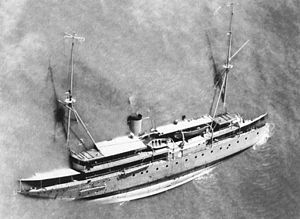 Krakatau capsized in 1932 Krakatau capsized in 1932
| |
| History | |
|---|---|
| Name | Krakatau |
| Namesake | Krakatau |
| Operator | |
| Builder | Marine Etablissement te Soerabaja |
| Laid down | 3 February 1923 |
| Launched | 2 February 1924 |
| Commissioned | 11 December 1924 |
| Fate | Scuttled on 8 March 1942 |
| General characteristics | |
| Type | Minelayer |
| Displacement | 982 t (966 long tons) |
| Length | 65 m (213 ft 3 in) |
| Beam | 10.5 m (34 ft 5 in) |
| Draught | 3.2 m (10 ft 6 in) |
| Propulsion |
|
| Speed | 15.5 knots (28.7 km/h; 17.8 mph) |
| Crew | 91 |
| Armament |
|
HNLMS Krakatau was a minelayer of the Royal Netherlands Navy (RNN). She was built in the Dutch East Indies and served between 1924 and 1942 in the RNN.
Design and construction
Krakatau was laid down on 3 February 1923 and launched on 2 February 1924 at the Marine Etablissement te Soerabaja (MES). The ship was designed by the Dutch engineer R. O. Leegstra. After passing its sea trials in October 1924 Krakatau was commissioned on 11 December 1924. While the ship passed its sea trials, it did share a common flaw with other ships built at the MES at the time, namely stability problems. To counter this problem permanent ballast was added to the Krakatau, however, it did not manage to completely fix the stability problem of the ship.
Service history
On 11 October 1932 Krakatau capsized in the Oostervaarwater near Soerabaja. At the time the ship was doing a speed related exercise when it began taking water. It was theorized that this was the result of leaving the mine doors at the rear of the ship open. The increasing speed during the exercise would have led to high waves that would land on the rear of the ship, which could pour inside through the open doors. Eventually the water inside the ship gathered at one side of the ship and it slowly capsized. On 4 December 1932 Krakatau was re-floated and towed to the MES. There it was determined that the ship had taken minimal damage and would be fully repaired. The next year, on 4 September 1933, Krakatau was taken back into service.
Second World War
Between 19 and 20 February 1942 Krakatau acted as a motor torpedo boat tender for a division of motor torpedo boats and took part in the Battle of Badung Strait. Shortly after the battle the ship provided gasoline to motor torpedo boats in the Pangpang Baai. During this time it managed to stay hidden and unharmed, even when Japanese scouts and bombers flew over, as a result of its carefully applied camouflage.
On 8 March 1942 Krakatau was scuttled by its crew 500 meters from the dock of the Pyrotechnische Werkplaatsen in the Westervaarwater near Batoe Porron in Madoera. The ship was scuttled because there was not enough oil to make the journey to an Allied port and it was determined that it had not much fighting value as a warship. Afterwards the crew of the ship left for Kamal to continue the battle on land against the Japanese.
Notes
- In Dutch it is described as steiger.
Citations
- ^ Mark (1997), p. 98.
- ^ von Münching (1978), p. 68.
- Raven (1988), p. 181.
- "Terwaterlating van een Mijnenlegger". De Indische Courant (in Dutch). 4 February 1924.
- "De "Krakatau"". Het nieuws van den dag voor Nederlandsch-Indië (in Dutch). 13 October 1942.
- "De mijnenlegger "Krakatau"". De Telegraaf (in Dutch). 22 October 1924.
- "De Nieuwe mijnenlegger". Algemeen handelsblad voor Nederlandsch-Indië (in Dutch). 20 October 1924.
- ^ Roetering (1997), p. 22.
- ^ "De "Krakatau": De vermoedelijke oorzaak". Bataviaasch Nieuwsblad (in Dutch). 14 October 1932.
- "De mijnenlegger "Krakatau" omgeslagen". Nieuwsblad van Friesland (in Dutch). 12 October 1932.
- ^ "De mijnenlegger "Krakatau" omgeslagen: Een bijzonder gelukkige afloop zonder slachtoffers". Algemeen handelsblad voor Nederlandsch-Indië (in Dutch). 13 October 1932.
- "De "Krakatau": Naar Soerabaja gesleept". Nieuwe Haarlemsche Courant (in Dutch). 6 December 1932.
- "De "Krakatau": Wordt volledig hersteld". Algemeen Handelsblad (in Dutch). 27 December 1932.
- ^ Mark (1997), p. 99.
- ^ Bosscher (1986), p. 268.
- ^ Bosscher (1986), p. 335.
References
- Mark, Chris (1997). Schepen van de Koninklijke Marine in W.O. II (in Dutch). Alkmaar: De Alk. ISBN 90-6013-522-9.
- von Münching, L.L. (1978). Schepen van de Koninklijke Marine in de Tweede Wereldoorlog (in Dutch). Alkmaar: Alk. ISBN 90-6013-903-8.
- Bosscher, Ph.M. (1986). De Koninklijke Marine in de Tweede Wereldoorlog (in Dutch). Vol. 2: Indië tot en met 8 maart 1942. Franeker: Wever. ISBN 90-6135-372-6.
- Roetering, B., ed. (1997). Mijnendienst 1907-1997 90 jaar: feiten, verhalen en anekdotes uit het negentigjarig bestaan van de Mijnendienst van de Koninklijke Marine (in Dutch). ISBN 90-90-10528-X.
- Raven, G.J.A., ed. (1988). De kroon op het anker: 175 jaar Koninklijke Marine (in Dutch). Amsterdam: De Bataafsche Leeuw. ISBN 90-6707-200-1.
| Dutch naval ship classes of World War II | |||||||
|---|---|---|---|---|---|---|---|
| Battlecruisers | |||||||
| Light cruisers | |||||||
| Flotilla leaders | |||||||
| Destroyers | |||||||
| Frigates | |||||||
| Corvettes | |||||||
| Torpedo boats | |||||||
| Gunboats and sloops | |||||||
| Submarines |
| ||||||
| Mine warfare vessels |
| ||||||
| Patrol boats | |||||||
| Motor torpedo boats | |||||||
| Auxiliary ships | |||||||
| Research vessels | |||||||
| Other | |||||||
| |||||||